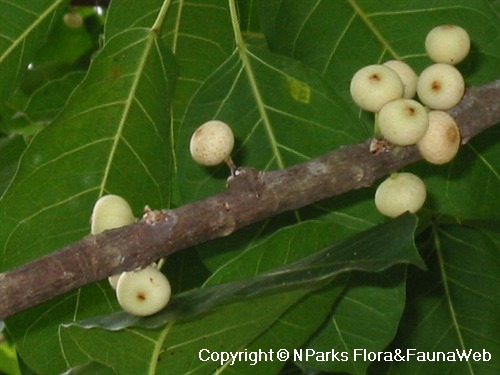
Name
Classifications and Characteristics
| Plant Division | Angiosperms (Flowering Seed Plants) (Dicotyledon) |
|---|---|
| Plant Growth Form | Tree (Shrubby (1m-5m), Small (6m-15m)), Shrub |
| Lifespan (in Singapore) | Perennial |
| Mode of Nutrition | Autotrophic |
| Plant Shape | Irregular |
| Maximum Height | 1 m to 15 m |
Biogeography
| Native Distribution | Indochina, Peninsular Malaysia, Singapore, the Philippines, and Borneo |
|---|---|
| Native Habitat | Terrestrial (Primary Rainforest, Mountain, Secondary Rainforest, Disturbed Area / Open Ground) |
| Preferred Climate Zone | Tropical |
| Local Conservation Status | Native to Singapore (Least Concern (LC)) |
Description and Ethnobotany
| Growth Form | It is a shrub or tree up to 15 m tall, with latex, and twigs covered with golden-yellow hair. |
|---|---|
| Foliage | Its spirally arranged, stalked leaves have thinly leathery to papery leaf blades that are drop-shaped or oval, 5–30 by 2–25 cm, and covered with golden-yellow hair. |
| Flowers | The plant is dioecious with each plant bearing male or female flowers. The flowers are tiny and develop within the syconium (fig). |
| Fruit | Its syconia (figs) are in pairs, in the leaf axils or on the bare portions of twigs behind the leaves, somewhat-round to ellipsoid, 1.5–2.2 cm across when fresh, red at maturity, and densely covered with golden-yellow hair. |
| Habitat | It grows in lowlands to lower montane forests, including secondary forests, and also in forest edges, hedges, and open sites, up to 1,400 m altitude. It occurs locally in the Central Catchment Nature Reserve, Old Turf Club, Pulau Tekong, near Lorong Gangsa, and Woodlands Road. |
| Associated Fauna | Its flowers are pollinated by fig wasps of the genus Blastophaga and subgenus Valisia. |
| Cultivation | It can be propagated by seed. |
| Etymology | Latin Ficus, the commercial edible fig (Ficus carica); Latin aurata, ornamented with gold, possibly referring to the golden-yellow hairy syconia (figs), leaves, and twigs |
Landscaping Features
| Landscaping | It may be suitable for parks or roadsides. |
|---|---|
| Desirable Plant Features | Ornamental Fruits |
| Landscape Uses | General, Suitable for Roadsides, Parks & Gardens, Small Gardens |
Fauna, Pollination and Dispersal
| Fauna Pollination Dispersal Associated Fauna | Bird-Attracting |
|---|---|
| Pollination Method(s) | Biotic (Fauna) |
| Seed or Spore Dispersal | Biotic (Fauna) |
Plant Care and Propagation
| Light Preference | Full Sun |
|---|---|
| Water Preference | Moderate Water |
| Plant Growth Rate | Moderate |
| Rootzone Tolerance | Moist Soils, Well-Drained Soils, Fertile Loamy Soils |
| Maintenance Requirements | Moderate |
| Propagation Method | Seed |
Foliar
| Foliage Retention | Evergreen |
|---|---|
| Mature Foliage Colour(s) | Green |
| Mature Foliage Texture(s) | Hairy / Hirsute, Papery, Leathery, Thin |
| Foliar Type | Simple / Unifoliate |
| Foliar Arrangement Along Stem | Alternate, Spiral |
| Foliar Attachment to Stem | Petiolate |
| Foliar Shape(s) | Non-Palm Foliage (Obovate, Oval) |
| Foliar Venation | Pinnate / Net |
Floral (Angiosperm)
| Flower & Plant Sexuality | Unisexual Flowers, Dioecious |
| Flower Grouping | Cluster / Inflorescence |
|---|
| Inflorescence Type | Syconium |
Fruit, Seed and Spore
| Mature Fruit Colour(s) | Red |
|---|---|
| Mature Fruit Texture(s) | Hairy / Hirsute |
| Fruit Classification | Multiple Fruit |
| Fruit Type |
Image Repository
Others
| Master ID | 31561 |
|---|---|
| Species ID | 5960 |
| Flora Disclaimer | The information in this website has been compiled from reliable sources, such as reference works on medicinal plants. It is not a substitute for medical advice or treatment and NParks does not purport to provide any medical advice. Readers should always consult his/her physician before using or consuming a plant for medicinal purposes. |







.jpg)